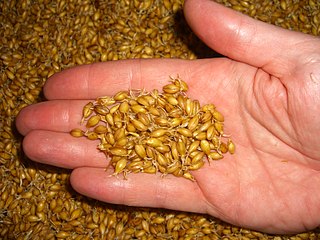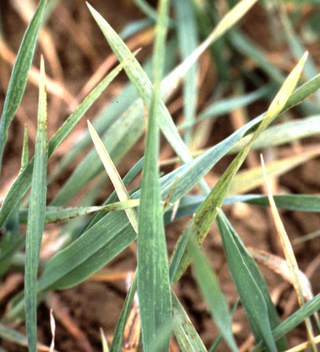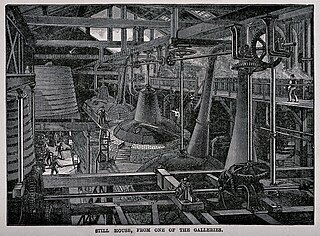
A cereal is a grass cultivated for its edible grain. Cereals are the world's largest crops, and are therefore staple foods. They include rice, wheat, rye, oats, barley, millet, and maize. Edible grains from other plant families, such as buckwheat and quinoa are pseudocereals. Most cereals are annuals, producing one crop from each planting, though rice is sometimes grown as a perennial. Winter varieties are hardy enough to be planted in the autumn, becoming dormant in the winter, and harvested in spring or early summer; spring varieties are planted in spring and harvested in late summer. The term cereal is derived from the name of the Roman goddess of grain crops and fertility, Ceres.

Malt is a cereal grain that has been made to germinate by soaking in water and then stopped from germinating further by drying with hot air, a process known as "malting". Malted grain is used to make beer, whisky, malted milk, malt vinegar, confections such as Maltesers and Whoppers, flavored drinks such as Horlicks, Ovaltine, and Milo, and some baked goods, such as malt loaf, bagels, and Rich Tea biscuits. Malted grain that has been ground into a coarse meal is known as "sweet meal".

Scotch whisky is malt whisky or grain whisky, made in Scotland.

Whisky or whiskey is a type of liquor made from fermented grain mash. Various grains are used for different varieties, including barley, corn, rye, and wheat. Whisky is typically aged in wooden casks, which are typically made of charred white oak. Uncharred white oak casks previously used for the aging of port, rum or sherry are also sometimes used.

Hordeum is a genus of annual and perennial plants in the grass family. They are native throughout the temperate regions of Africa, Eurasia, and the Americas.

Emmer wheat or hulled wheat is a type of awned wheat. Emmer is a tetraploid. The domesticated types are Triticum turgidum subsp. dicoccum and T. t. conv. durum. The wild plant is called T. t. subsp. dicoccoides. The principal difference between the wild and the domestic forms is that the ripened seed head of the wild plant shatters and scatters the seed onto the ground, while in the domesticated emmer, the seed head remains intact, thus making it easier for humans to harvest the grain.

Islay single malts are the single malt Scotch whiskies made on Islay or Ìle in Gaelic, one of the southernmost of the Inner Hebridean Islands located off the west coast of Scotland. Islay is one of five whisky distilling localities and regions in Scotland whose identity is protected by law.

Shortbread or shortie is a traditional Scottish biscuit usually made from one part white sugar, two parts butter, and three to four parts plain wheat flour. Shortbread does not contain any leavening, such as baking powder or baking soda. Shortbread is widely associated with Christmas and Hogmanay festivities in Scotland, and some Scottish brands are exported around the world.
Pyrenophora teres is a necrotrophic fungal pathogen of some plant species, the most significant of which are economically important agricultural crops such as barley. Toxins include aspergillomarasmine A and related compounds.

Mash ingredients, mash bill, mashbill, or grain bill are the materials that brewers use to produce the wort that they then ferment into alcohol. Mashing is the act of creating and extracting fermentable and non-fermentable sugars and flavor components from grain by steeping it in hot water, and then letting it rest at specific temperature ranges to activate naturally occurring enzymes in the grain that convert starches to sugars. The sugars separate from the mash ingredients, and then yeast in the brewing process converts them to alcohol and other fermentation products.

Scottish cuisine encompasses the cooking styles, traditions and recipes associated with Scotland. It has distinctive attributes and recipes of its own, but also shares much with other British and wider European cuisine as a result of local, regional, and continental influences—both ancient and modern.

Hordeum jubatum, with common names foxtail barley, bobtail barley, squirreltail barley, and intermediate barley, is a perennial plant species in the grass family Poaceae. It occurs wild mainly in northern North America and adjacent northeastern Siberia. However, as it escaped often from gardens it can be found worldwide in areas with temperate to warm climates, and is considered a weed in many countries. The species is a polyploid and originated via hybridization of an East Asian Hordeum species with a close but extinct relative of Californian H. brachyantherum. It is grown as an ornamental plant for its attractive inflorescences and when done flowering for its inflorescence.

Hordeum murinum is a species of flowering plant in the grass family Poaceae, commonly known as wall barley or false barley. It is a close relative of cultivated barley.

Barley yellow mosaic virus is plant pathogenic virus that causes the yellow mosaic disease of barley. Its shape is categorized as being flexuous filamentous, with lengths of 275 and 550 nanometers. The virus has a limited host range, and barley appears to be the only known susceptible host. The virus is transmitted via Polymyxa graminis, which is a plasmodiophorid protist, through the resting spores that survive in the soil, and eventually zoospores. Eastern Asia is the most affected region, but the virus can be found worldwide. Current agricultural practices have been ineffective at eliminating the virus, but breeding resistance appears to be the only way to help reduce the disease.

Elymus canadensis, synonyms including Elymus wiegandii, commonly known as Canada wild rye or Canadian wildrye, is a species of wild rye native to much of North America. It is most abundant in the central plains and Great Plains. It grows in a number of ecosystems, including woodlands, savannas, dunes, and prairies, sometimes in areas that have been disturbed.

Barley, a member of the grass family, is a major cereal grain grown in temperate climates globally. It was one of the first cultivated grains; it was domesticated in the Fertile Crescent around 9000 BC, giving it nonshattering spikelets and making it much easier to harvest. Its use then spread throughout Eurasia by 2000 BC. Barley prefers relatively low temperatures to grow, and well-drained soil. It is relatively tolerant of drought and soil salinity, but is less winter-hardy than wheat or rye.

English whisky is a liquor made from cereal grains, malt and water. There are currently two types of English whiskies produced malt whisky and grain whisky.

Hordeum spontaneum, commonly known as wild barley or spontaneous barley, is the wild form of the grass in the family Poaceae that gave rise to the cereal barley. Domestication is thought to have occurred on two occasions, first about ten thousand years ago in the Fertile Crescent and again later, several thousand kilometres further east.
Golden Promise is a variety of spring-sown two-row barley. It was developed in the 1950s by exposing an existing variety to gamma radiation with the aim of producing a semi-dwarf variety of barley that had good malting characteristics. It became very popular with farmers during the 1970s but began to be replaced by higher yielding varieties in the 1980s. Due to its perceived better flavour than these more modern varieties, a niche market was maintained and it is still favoured by craft brewers. It has been used by researchers to study the genetics of barley and to investigate the effect of barley on the flavour of beer.

The following outline is provided as an overview of and topical guide to whisky:






















